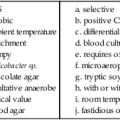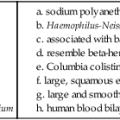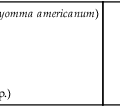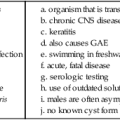Bordetella pertussis, Bordetella parapertussis, and Related Species
1. Describe the general characteristics of the Bordetella spp.
2. State the normal habitat and routes of transmission for Bordetella pertussis and Bordetella parapertussis.
3. Describe the three stages of pertussis, including the duration and symptoms.
4. Describe the proper collection and transport of specimens for the detection of B. pertussis and B. parapertussis.
5. Explain the limitations of direct fluorescent antibody (DFA) and polymerase chain reaction (PCR) methods for detecting B. pertussis, including assay specificity and sensitivity.
6. Describe the optimum condition for culturing B. pertussis, including specimens of choice for optimal recovery.
7. Outline the major tests used to identify and differentiate B. pertussis and B. parapertussis.
8. Correlate the patient’s signs and symptoms and laboratory results to identify the etiologic agent associated with infection.
The genus Bordetella includes three primary human pathogens: Bordetella bronchiseptica, B. pertussis, and B. parapertussis. B. bronchiseptica is reviewed in Chapter 25 because it grows on MacConkey agar. Although B. parapertussis also can grow on MacConkey agar, it is discussed with B. pertussis in this chapter for two reasons: B. pertussis and B. parapertussis both cause human upper respiratory tract infections, with almost identical symptoms, epidemiology, and therapeutic management; and optimal recovery of both organisms from respiratory specimens requires the addition of blood and/or other suitable factors to culture media. Additional Bordetella species may cause rare asymptomatic infections in immunocompromised patients; these include B. hinzii, B. holmesii, B. petrii, and B. trematum. (See the chapter cross-references in the preceding table for information on organisms not discussed in this chapter.)
General Characteristics
General features of Bordetella spp. other than B. pertussis and B. parapertussis are summarized in Chapter 25. In contrast to B. bronchiseptica, B. pertussis and B. parapertussis are nonmotile and infect only humans. In the evolutionary process, these exclusive human pathogens have a close genetic relationship. They remain separate species based on their differences in pathogenesis and host range.
Epidemiology and Pathogenesis
Epidemiology
Pathogenesis
B. pertussis, the primary pathogen of whooping cough, uses several mechanisms to overcome the immune defenses of healthy individuals. The mechanisms are complex and involve the interplay of several virulence factors (Table 37-1). Some factors help establish infection; others are toxigenic to the host; and still others override specific components of the host’s mucosal defense system. For example, when B. pertussis reaches the host’s respiratory tract, its surface adhesins attach to respiratory ciliated epithelial cells and paralyze the beating cilia by producing a tracheal cytotoxin. A major virulence factor, pertussis toxin (PT), is produced by the attached organism. PT enters the bloodstream, subsequently binding to specific receptors on host cells. After binding, PT disrupts several host cell functions, such as initiation of host cell translation; inability of host cells to receive signals from the environment causes a generalized toxicity. The center membrane of B. pertussis blocks access of the host’s lysozyme to the bacterial cell wall via its outer membrane. B. pertussis and B. parapertussis share a nearly identical virulence control system encoded by the bvgAS locus that is responsive to variation in environmental conditions. Because of this very complex system, Bordetella organisms appear to be able to alter phenotypic expression, enhancing transmission, colonization, and survival.
TABLE 37-1
Major Virulence Determinants of Bordetella pertussis
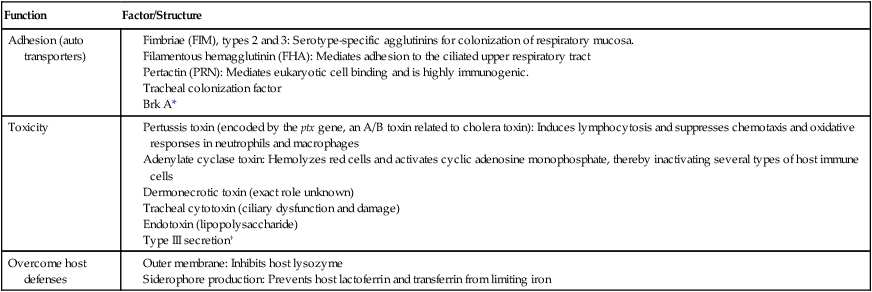
*Plays a role in pathogenesis by conferring serum resistance.
†This type of secretion allows Bordetella organisms to transport proteins directly into host cells; it is required for persistent tracheal colonization.
Spectrum of Disease
Several factors influence the clinical manifestations of B. pertussis (Box 37-1). Classic pertussis is usually a disease of children and can be divided into three symptomatic stages: catarrhal, paroxysmal, and convalescent. During the catarrhal stage, symptoms are the same as for a mild cold with a runny nose and mild cough; this stage may last several weeks. Episodes of severe and violent coughing increase in number, marking the beginning of the paroxysmal stage. As many as 15 to 25 paroxysmal coughing episodes can occur in 24 hours; these are associated with vomiting and with “whooping,” the result of air rapidly inspired into the lungs past the swollen glottis. Lymphocytosis occurs, although typically the patient has no fever and no signs and symptoms of systemic illness. This stage may last 1 to 4 weeks.
Laboratory Diagnosis
Specimen Collection, Transport, and Processing
Confirming the diagnosis of pertussis is challenging. Culture, which is most sensitive early in the illness, has been the traditional diagnostic standard for pertussis and shows nearly 100% specificity but varied sensitivity. Organisms may become undetectable by culture 2 weeks after the start of paroxysms. Nasopharyngeal aspirates or a nasopharyngeal swab (calcium-alginate or Dacron on a wire handle) are acceptable specimens, because B. pertussis colonizes the ciliated epithelial cells of upper respiratory tract. Calcium-alginate swabs with aluminum shafts are not recommended for PCR, because they may inhibit the polymerase enzyme in PCR detection. In addition, cotton swabs may be inhibitory to specimen growth and are not recommended. Specimens obtained from the throat, sputum, or anterior nose are unacceptable, because these sites are not lined with ciliated epithelium. For collection, the swab is bent to conform to the nasal passage and held against the posterior aspect of the nasopharynx. If coughing does not occur, another swab is inserted into the other nostril to initiate the cough. The swab is left in place during the entire cough, removed, and immediately inoculated onto a selective medium at the bedside (Table 37-2).
TABLE 37-2
Examples of Selective Media for Primary Isolation of B. pertussis and B. parapertussis
| Agar Media | Description |
| Bordet-Gengou | Potato infusion agar with glycerol and sheep blood with methicillin or cephalexin* (short shelf-life) |
| Modified Jones-Kendrick charcoal | Charcoal agar with yeast extract, starch, and 40 µg cephalexin (2- to 3-month shelf-life but inferior to Regan-Lowe agar) |
| Regan-Lowe† | Charcoal agar with 10% horse blood and cephalexin (4- to 8-week shelf-life) |
| Stainer-Scholte | Synthetic agar lacking blood products |
*Cephalexin is superior to methicillin and penicillin for inhibiting normal respiratory flora.
†Regan-Lowe agar has been found to work best for recovery of B. pertussis from nasopharyngeal swabs.
Direct Detection Methods
A DFA stain using polyclonal antibodies against B. pertussis and B. parapertussis is commercially available for detection of B. pertussis in smears made from nasopharyngeal (NP) material (Becton Dickinson, Sparks, Maryland); an NP specimen that is DFA positive for B. pertussis is shown in Figure 6-15, B. Although rapid, this DFA stain has limited sensitivity and variable specificity; therefore, the DFA test should always be used in conjunction with culture. DFA monoclonal reagent is also commercially available with two antisera with different fluorophores to detect B. pertussis and B. parapertussis (Accu-Mab, Altachem Pharma, Edmonton, Canada).
Because of the limitations associated with culture and serologic diagnostic methods, significant effort has been put into developing nucleic acid amplification methods. Most diagnostic studies use direct detection of B. pertussis and B. parapertussis by various PCR procedures, including real-time PCR. These assays have a diagnostic sensitivity at least comparable (and in most cases superior) to that of culture. A word of caution: Positive results have been obtained with samples containing B. holmesii and B. bronchiseptica (see Chapter 25) depending on the sequence targeted in conventional and real-time PCR assays. Most laboratories use transposon insertion sequences IS481 for B. pertussis and IS1001 for B. parapertussis. However, strains of B. holmesii, B. parapertussis, and B. bronchiseptica that carry IS481 have been identified; therefore, careful interpretation of results and correlation with the clinical presentation are required. Additional PCR assays are available for the detection of the pertussis toxin, fimbriae, pertactin and a porin gene. However, because these are single-copy genes and not multicopy insertion sequences, assay sensitivity is reduced. Nasopharyngeal swabs (rayon or Dacron swabs on plastic shafts) and aspirates are the two types of samples primarily used for pertussis PCR; calcium-alginate swabs are unacceptable, as previously mentioned, because these inhibit PCR-based detection.
Cultivation
Regan-Lowe agar, Bordet-Gengou agar, and Stainer-Scholte synthetic medium are suitable culture media. Regan-Lowe agar contains beef extract, starch, casein digest, and charcoal supplemented with horse blood. Bordet-Gengou agar is a potato fusion base containing glycerol and either sheep or horse blood. Most media contain cephalexin as an additive for suppression of contaminating organisms. Young colonies of B. pertussis and B. parapertussis are small and shiny, resembling mercury drops; colonies become whitish gray with age (Figure 37-1).
Approach to Identification
A Gram stain of the organism reveals minute, faintly staining coccobacilli singly or in pairs (Figure 37-2). Use of a 2-minute safranin “O” counterstain or a 0.2% aqueous basic fuchsin counterstain enhances their visibility. Bordetella spp. characteristics are presented in Table 37-3. The DFA reagent is used to presumptively identify organisms. Whole-cell agglutination reactions in specific antiserum can be used for species identification.
TABLE 37-3
Characteristics That Differentiate Bordetella spp.
| Characteristic | B. pertussis | B. parapertussis | B. bronchiseptica |
| Catalase | + | + | + |
| Oxidase | + | − | + |
| Motility | − | − | + |
| Nitrate | − | − | + |
| Urease | − | + (24 hours) | + (4 hours) |
| Growth | |||
| Regan-Lowe agar | 3-6 days | 2-3 days | 1-2 days |
| Blood agar | − | + | + |
| MacConkey agar | − | +/− | + |
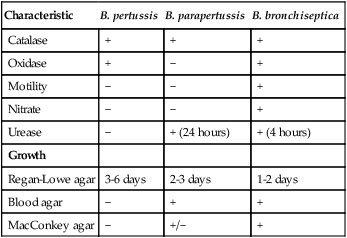
1. The primary pathogen of whooping cough is:
2. What is the specimen of choice for culturing B. pertussis?
3. Which selective media should not be used for primary isolation of B. pertussis?
4. Which specimen is not acceptable for B. pertussis PCR?
6. A PCR sample for B. pertussis tests positive for IS1001 from a nasopharyngeal sample. The technologist should:
7. An NP sample for B. pertussis is DFA positive. The technologist should:
8. The most reliable serologic test for diagnosis of B. pertussis in adults and adolescents is:
9. An organism is cultured on Bordet-Gengou agar and grown at 35°C in a humid atmosphere. The organism is detected at 72 hours. This organism is most likely:
10. Which of the following is not an effective transport medium for Bordetella spp. when the specimen will be sent overnight to a reference laboratory?
_____ B. pertussis infections are endemic as a result of waning vaccine-induced immunity.
_____ B. pertussis organisms paralyze the cilia with tracheal cytotoxins.
_____ Bordetella organisms are detectable by culture for up to 2 months after the start of paroxysms.
_____ Whole-cell vaccines are now used instead of an acellular vaccine because of adverse reactions seen with the latter.
_____ B. holmesii has been cultured in individuals working with poultry.
12. Matching: Match each term with the appropriate description.





